

Compact Muon Solenoid
LHC, CERN
| CMS-EXO-21-014 ; CERN-EP-2022-276 | ||
| Search for long-lived particles using out-of-time trackless jets in proton-proton collisions at $ \sqrt{s} = $ 13 TeV | ||
| CMS Collaboration | ||
| 13 December 2022 | ||
| JHEP 07 (2023) 210 | ||
| Abstract: A search for long-lived particles decaying in the outer regions of the CMS silicon tracker or in the calorimeters is presented. The search is based on a data sample of proton-proton collisions at $ \sqrt{s} = $ 13 TeV recorded with the CMS detector at the LHC in 2016--2018, corresponding to an integrated luminosity of 138 fb$ ^{-1} $. A novel technique, using nearly trackless and out-of-time jet information combined in a deep neural network discriminator, is employed to identify decays of long-lived particles. The results are interpreted in a simplified model of chargino-neutralino production, where the neutralino is the next-to-lightest supersymmetric particle, is long-lived, and decays to a gravitino and either a Higgs or Z boson. This search is most sensitive to neutralino proper decay lengths of approximately 0.5 m, for which masses up to 1.18 TeV are excluded at 95% confidence level. The current search is the best result to date in the mass range from the kinematic limit imposed by the Higgs boson mass up to 1.8 TeV. | ||
| Links: e-print arXiv:2212.06695 [hep-ex] (PDF) ; CDS record ; inSPIRE record ; HepData record ; CADI line (restricted) ; | ||
| Figures | |

png pdf |
Figure 1:
Feynman diagrams of the effective neutralino pair production in the GMSB simplified model in which the two neutralinos decay into two gravitinos ($ \tilde{\mathrm{G}} $) and two Z bosons (left), a Z and a Higgs boson (H) (center), or two Higgs bosons (right). |
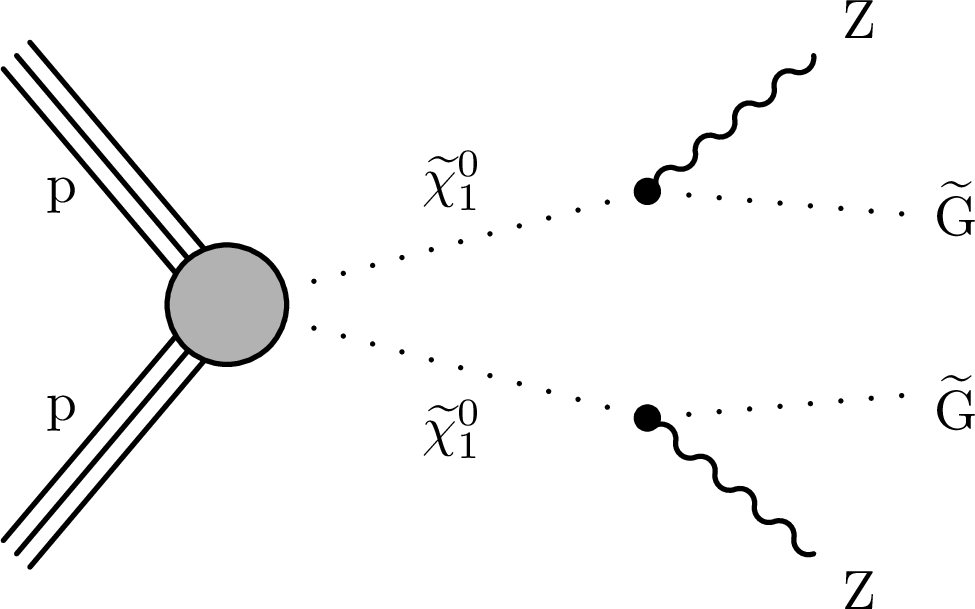
png pdf |
Figure 1-a:
Feynman diagram of the effective neutralino pair production in the GMSB simplified model in which the two neutralinos decay into two gravitinos ($ \tilde{\mathrm{G}} $) and two Z bosons. |
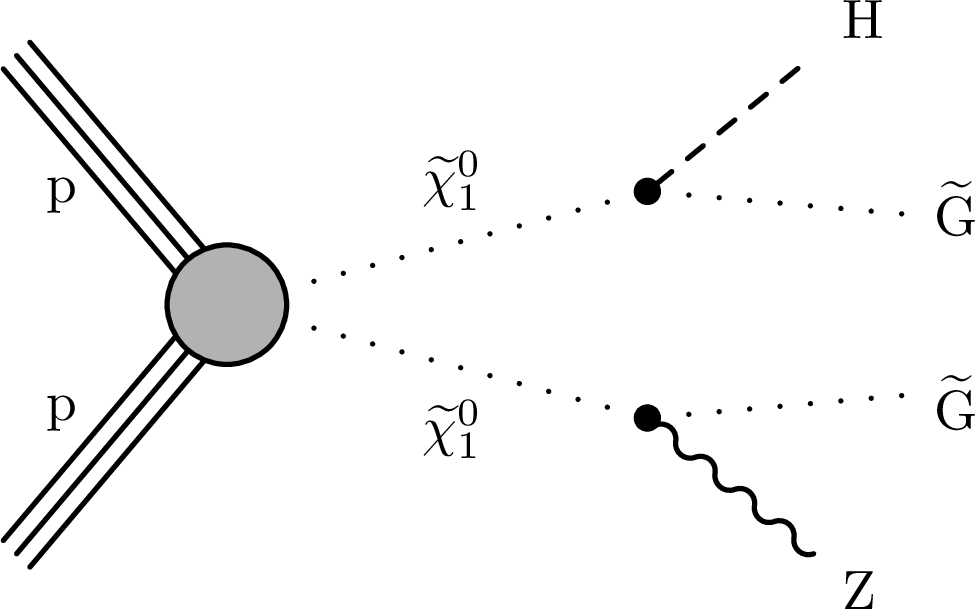
png pdf |
Figure 1-b:
Feynman diagram of the effective neutralino pair production in the GMSB simplified model in which the two neutralinos decay into two gravitinos ($ \tilde{\mathrm{G}} $) and a Z and a Higgs boson. |

png pdf |
Figure 1-c:
Feynman diagram of the effective neutralino pair production in the GMSB simplified model in which the two neutralinos decay into two gravitinos ($ \tilde{\mathrm{G}} $) and two Higgs bosons. |
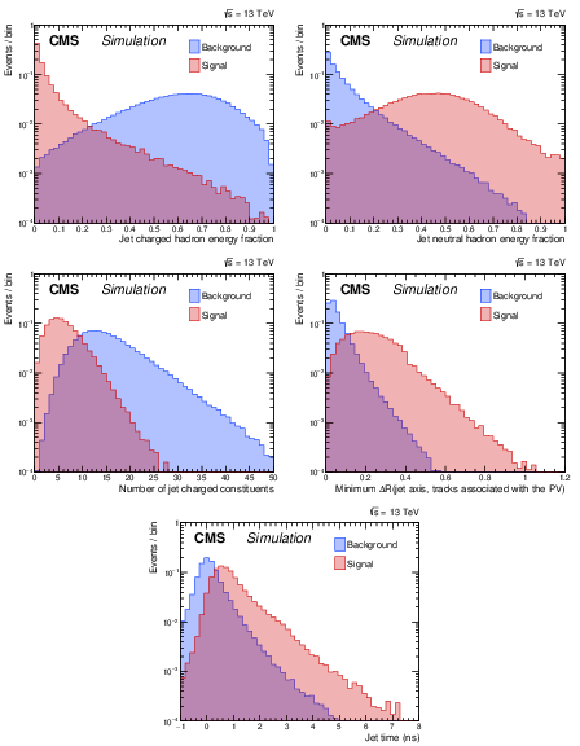
png pdf |
Figure 2:
The distributions of the most impactful input variables to the TD jet tagger for signal (red, lighter) and collision background (blue, darker). They include the charged (upper left) and neutral (upper right) hadron energy fractions, the number of track constituents in the jet (middle left), the $ \Delta R $ between the jet axis and the closest track associated with the PV (middle right), and the jet time (lower). |

png pdf |
Figure 2-a:
Distribution of the charged hadron energy fraction for signal (red, lighter) and collision background (blue, darker). |
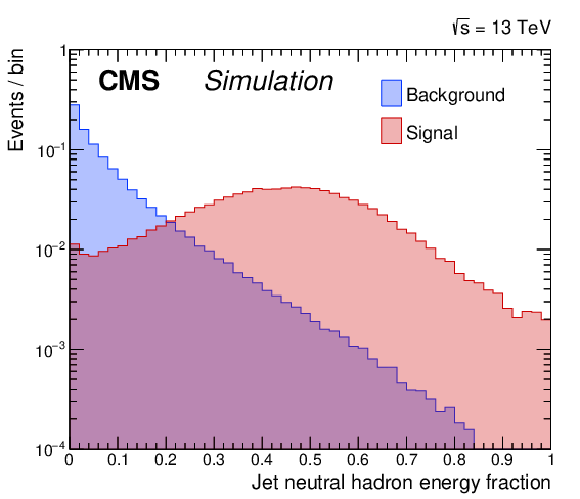
png pdf |
Figure 2-b:
Distribution of the neutral hadron energy fraction for signal (red, lighter) and collision background (blue, darker). |
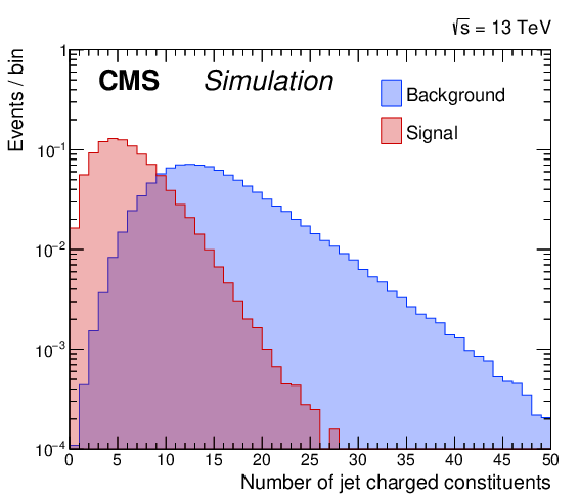
png pdf |
Figure 2-c:
Distribution of the number of track constituents in the jet for signal (red, lighter) and collision background (blue, darker). |
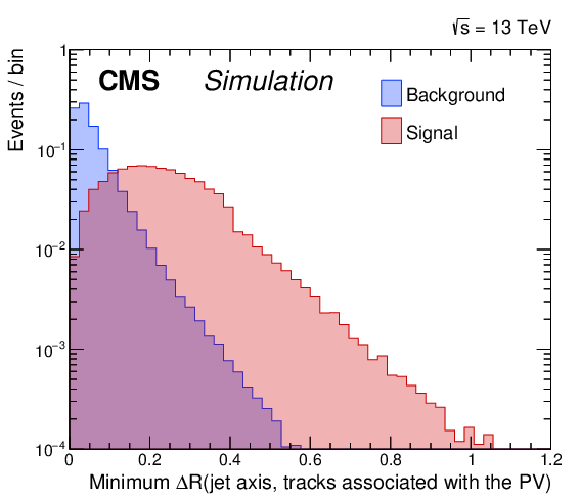
png pdf |
Figure 2-d:
Distribution of the $ \Delta R $ between the jet axis and the closest track associated with the PV for signal (red, lighter) and collision background (blue, darker). |
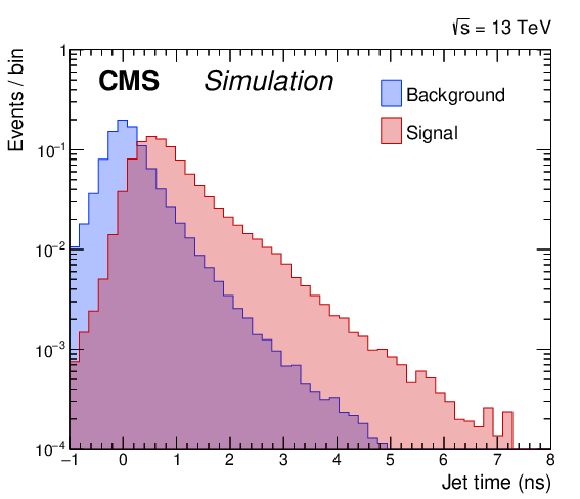
png pdf |
Figure 2-e:
Distribution of the jet time for signal (red, lighter) and collision background (blue, darker). |
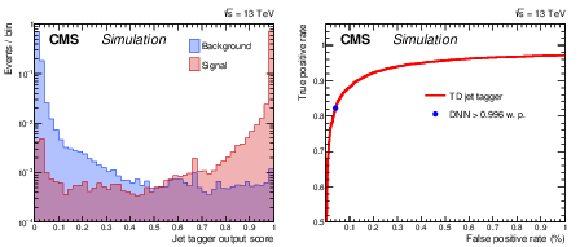
png pdf |
Figure 3:
TD jet tagger score distributions (left) for signal (red, lighter) and collision background (blue, darker). Identification probability for the signal versus the misidentification probability for the background (right) with the tagger working point (w. p.) used in the analysis shown as a blue marker. Both are evaluated using an independent sample of testing events. |
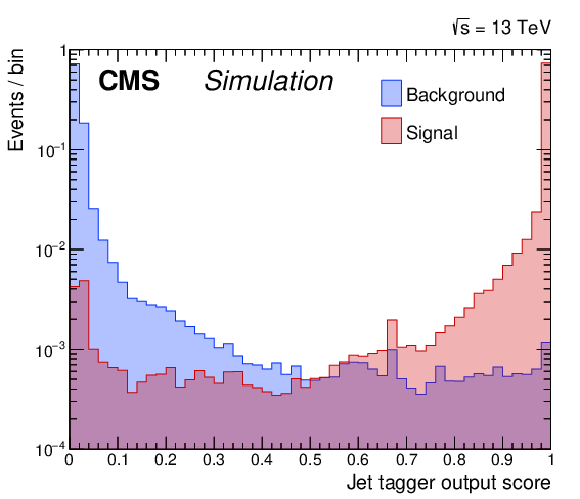
png pdf |
Figure 3-a:
TD jet tagger score distributions for signal (red, lighter) and collision background (blue, darker). |
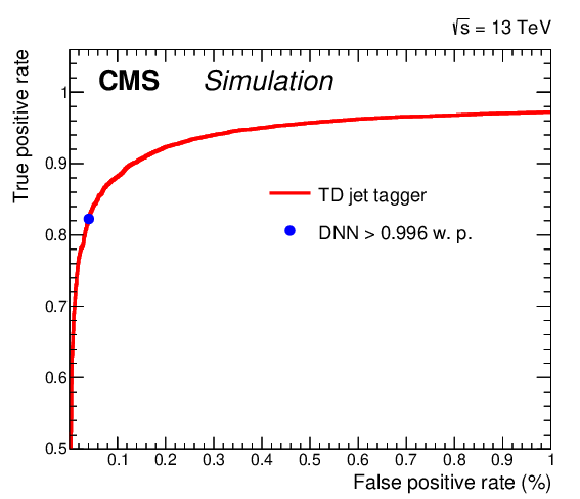
png pdf |
Figure 3-b:
Identification probability for the signal versus the misidentification probability for the background with the tagger working point (w. p.) used in the analysis shown as a blue marker. Both are evaluated using an independent sample of testing events. |
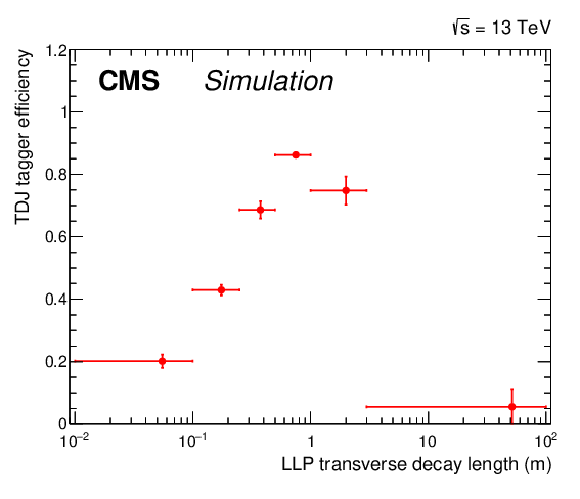
png pdf |
Figure 4:
The efficiency of the TD jet tagger working point used in the analysis is shown as a function of the lab frame transverse decay length for simulated signals with $ \tilde{\chi}_{1}^{0} $ mass of 400 GeV. The uncertainties shown account for lifetime dependence and statistical uncertainty. |

png pdf |
Figure 5:
The TD jet tagger score distributions for simulation (shaded histogram) and data (black markers) when using electrons from $ \mathrm{W}\to\mathrm{e}\nu_{\!\mathrm{e}} $ events as proxy objects for signal jets. The histograms and data points have been normalized to unit area. The last bin contains jets with tagger scores greater than 0.996, the threshold used to tag signal jets. Similar levels of agreement are observed for photon proxy objects from the $ \mathrm{Z}\to\ell^{+}\ell^{-}\gamma $ sample. |
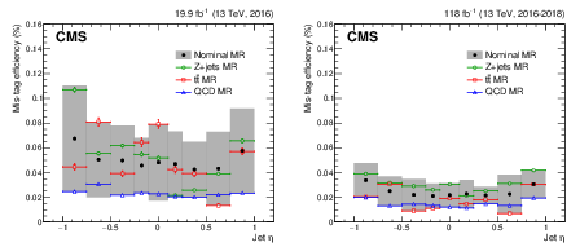
png pdf |
Figure 6:
The TD jet tagger misidentification probability measured using the nominal W+jets MR (black round markers) is shown along with the systematic uncertainty (gray band), quantifying the degree of process dependence measured from alternative MRs. The measurements in the alternative MRs are displayed as well (Z+jets MR as green round markers, $ \mathrm{t} \overline{\mathrm{t}} $ MR as red squared markers, QCD MR as blue triangular markers) along with their respective statistical uncertainty. On the left, this probability is shown for the first 19.9 fb$ ^{-1} $ of data collected in 2016, while on the right it is shown for the last 16.4 fb$ ^{-1} $ of data collected in 2016 combined with data collected in 2017--2018. |
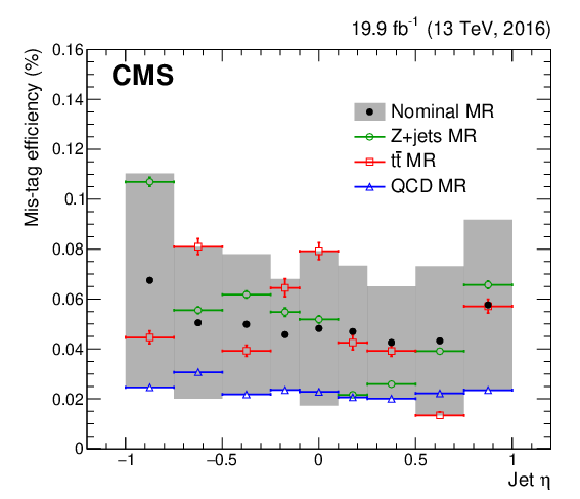
png pdf |
Figure 6-a:
The TD jet tagger misidentification probability measured using the nominal W+jets MR (black round markers) is shown along with the systematic uncertainty (gray band), quantifying the degree of process dependence measured from alternative MRs. The measurements in the alternative MRs are displayed as well (Z+jets MR as green round markers, $ \mathrm{t} \overline{\mathrm{t}} $ MR as red squared markers, QCD MR as blue triangular markers) along with their respective statistical uncertainty. This probability is shown for the first 19.9 fb$ ^{-1} $ of data collected in 2016. |
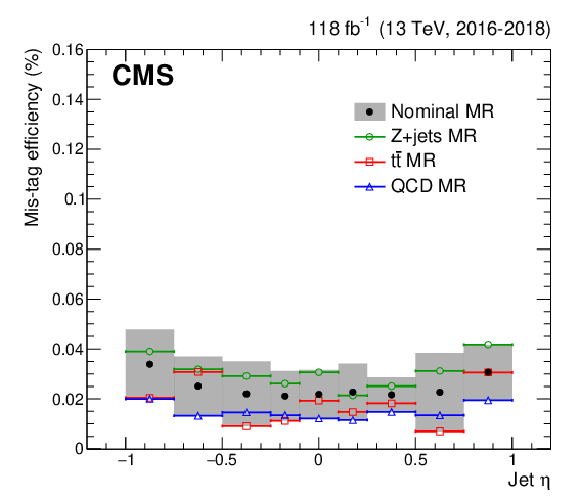
png pdf |
Figure 6-b:
The TD jet tagger misidentification probability measured using the nominal W+jets MR (black round markers) is shown along with the systematic uncertainty (gray band), quantifying the degree of process dependence measured from alternative MRs. The measurements in the alternative MRs are displayed as well (Z+jets MR as green round markers, $ \mathrm{t} \overline{\mathrm{t}} $ MR as red squared markers, QCD MR as blue triangular markers) along with their respective statistical uncertainty. This probability is shown for the last 16.4 fb$ ^{-1} $ of data collected in 2016 combined with data collected in 2017--2018. |
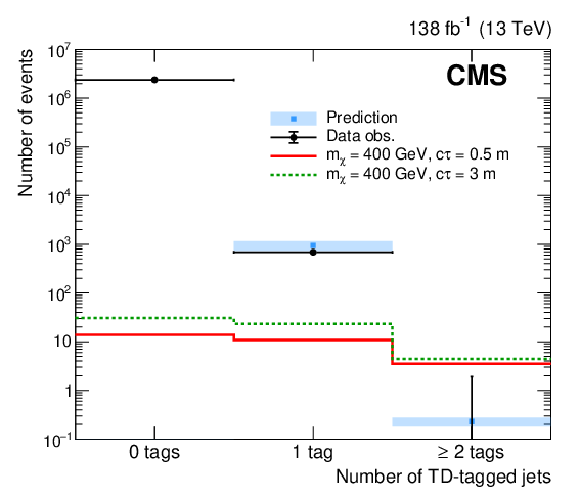
png pdf |
Figure 7:
Distribution of the number of TD-tagged jets for the $ m_{\tilde{\chi}_{1}^{0}} = $ 400 GeV simulated signal samples with $ c\tau_{\tilde{\chi}_{1}^{0}}= $ 0.5 m (solid red line) and $ c\tau_{\tilde{\chi}_{1}^{0}}= $ 3.0 m (dotted green line), estimated background (blue square markers), and data (black round markers). The signal distributions are normalized to the expected cross section limit. The blue shaded region indicates the systematic uncertainty in the background prediction. No background prediction is shown for the bin with zero TD-tagged jets as it is the main control region used to predict the background for the other two bins. There are zero observed events in the bin with two or more TD-tagged jets. |
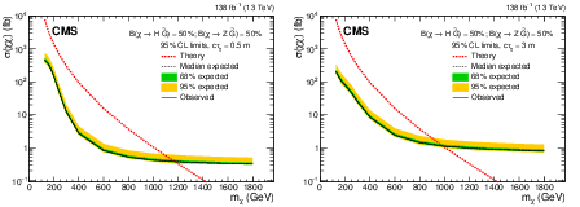
png pdf |
Figure 8:
Expected and observed 95% CL upper limits on $ \sigma_{\tilde{\chi}_{1}^{0}\tilde{\chi}_{1}^{0}} $ as functions of $ m_{\tilde{\chi}_{1}^{0}} $ in a scenario with $ \mathcal{B}(\tilde{\chi}_{1}^{0}\to\mathrm{H}\tilde{\mathrm{G}}) = $ 0.5 and $ c\tau = $ 0.5 m (left) or 3 m (right). |
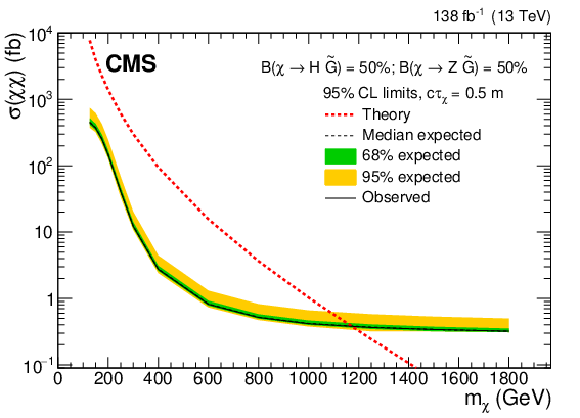
png pdf |
Figure 8-a:
Expected and observed 95% CL upper limits on $ \sigma_{\tilde{\chi}_{1}^{0}\tilde{\chi}_{1}^{0}} $ as functions of $ m_{\tilde{\chi}_{1}^{0}} $ in a scenario with $ \mathcal{B}(\tilde{\chi}_{1}^{0}\to\mathrm{H}\tilde{\mathrm{G}}) = $ 0.5 and $ c\tau = $ 0.5 m. |
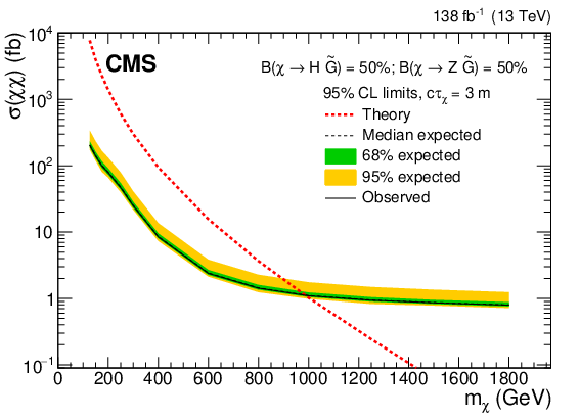
png pdf |
Figure 8-b:
Expected and observed 95% CL upper limits on $ \sigma_{\tilde{\chi}_{1}^{0}\tilde{\chi}_{1}^{0}} $ as functions of $ m_{\tilde{\chi}_{1}^{0}} $ in a scenario with $ \mathcal{B}(\tilde{\chi}_{1}^{0}\to\mathrm{H}\tilde{\mathrm{G}}) = $ 0.5 and $ c\tau = $ 3 m. |
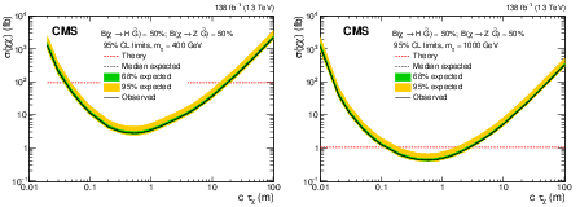
png pdf |
Figure 9:
Expected and observed 95% CL upper limits on $ \sigma_{\tilde{\chi}_{1}^{0}\tilde{\chi}_{1}^{0}} $ as functions of $ c\tau_{\tilde{\chi}_{1}^{0}} $ in a scenario with $ \mathcal{B}(\tilde{\chi}_{1}^{0}\to\mathrm{H}\tilde{\mathrm{G}}) = $ 0.5 and $ m_{\tilde{\chi}_{1}^{0}}= $ 400 GeV (left) or 1000 GeV (right). |
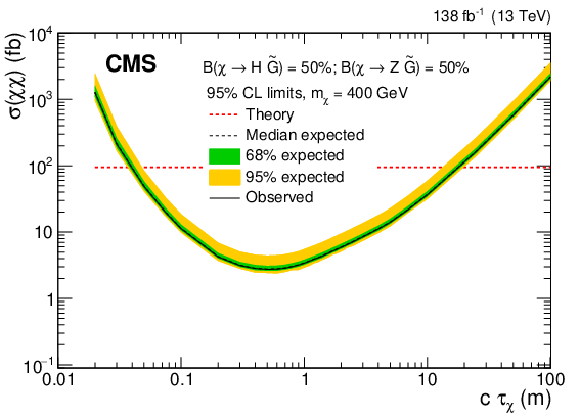
png pdf |
Figure 9-a:
Expected and observed 95% CL upper limits on $ \sigma_{\tilde{\chi}_{1}^{0}\tilde{\chi}_{1}^{0}} $ as functions of $ c\tau_{\tilde{\chi}_{1}^{0}} $ in a scenario with $ \mathcal{B}(\tilde{\chi}_{1}^{0}\to\mathrm{H}\tilde{\mathrm{G}}) = $ 0.5 and $ m_{\tilde{\chi}_{1}^{0}}= $ 400 GeV. |

png pdf |
Figure 9-b:
Expected and observed 95% CL upper limits on $ \sigma_{\tilde{\chi}_{1}^{0}\tilde{\chi}_{1}^{0}} $ as functions of $ c\tau_{\tilde{\chi}_{1}^{0}} $ in a scenario with $ \mathcal{B}(\tilde{\chi}_{1}^{0}\to\mathrm{H}\tilde{\mathrm{G}}) = $ 0.5 and $ m_{\tilde{\chi}_{1}^{0}}= $ 1000 GeV. |
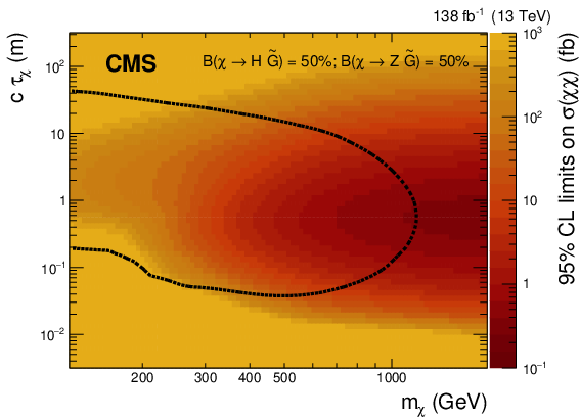
png pdf |
Figure 10:
The observed 95% CL upper limit on $ \sigma_{\tilde{\chi}_{1}^{0}\tilde{\chi}_{1}^{0}} $ as a function of $ m_{\tilde{\chi}_{1}^{0}} $ and $ c\tau_{\tilde{\chi}_{1}^{0}} $ in a scenario with $ \mathcal{B}(\tilde{\chi}_{1}^{0}\to\mathrm{H}\tilde{\mathrm{G}}) = $ 0.5. The area enclosed by the dotted black line corresponds to the observed excluded region. |
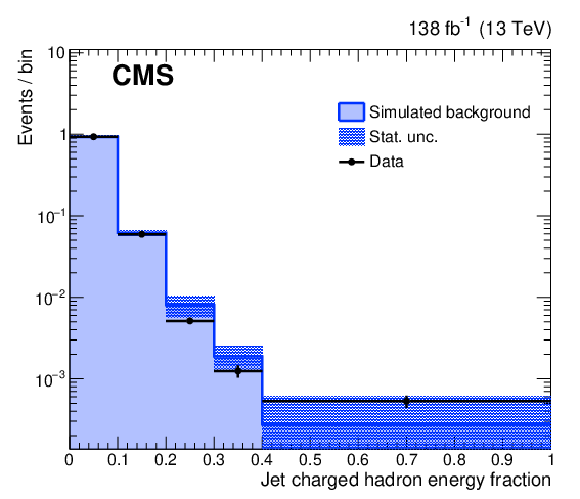
png pdf |
Figure 11:
The distribution of the jet charged hadron energy fraction, a variable used as input to the TD jet tagger score, for simulation (shaded histogram) and data (black markers) when using electrons from $ \mathrm{W}\to\mathrm{e}\nu_{\!\mathrm{e}} $ events as proxy objects for signal jets. The histograms and data points have been normalized to unit area. Similar levels of agreement are observed for photon proxy objects from the $ \mathrm{Z}\to\ell^{+}\ell^{-}\gamma $ sample. |
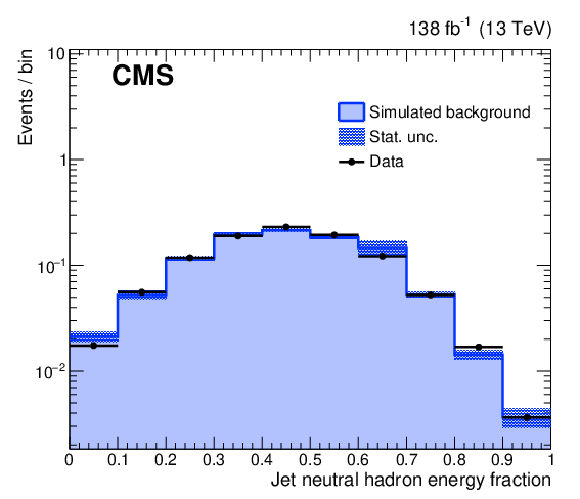
png pdf |
Figure 12:
The distribution of the jet neutral hadron energy fraction, a variable used as input to the TD jet tagger score, for simulation (shaded histogram) and data (black markers) when using electrons from $ \mathrm{W}\to\mathrm{e}\nu_{\!\mathrm{e}} $ events as proxy objects for signal jets. The histograms and data points have been normalized to unit area. Similar levels of agreement are observed for photon proxy objects from the $ \mathrm{Z}\to\ell^{+}\ell^{-}\gamma $ sample. |

png pdf |
Figure 13:
The distribution of the number of track constituents in the jet, a variable used as input to the TD jet tagger score, for simulation (shaded histogram) and data (black markers) when using electrons from $ \mathrm{W}\to\mathrm{e}\nu_{\!\mathrm{e}} $ events as proxy objects for signal jets. The histograms and data points have been normalized to unit area. Similar levels of agreement are observed for photon proxy objects from the $ \mathrm{Z}\to\ell^{+}\ell^{-}\gamma $ sample. |
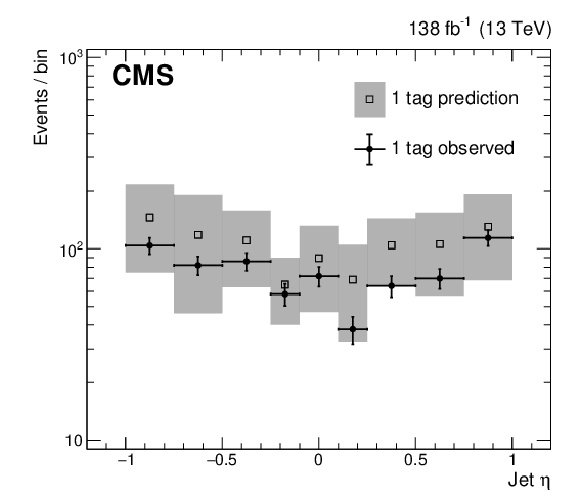
png pdf |
Figure 14:
The $ \eta $ distribution of TD-tagged jets in a background-enriched control region that comprises events with exactly one TD-tagged jet. Observed data (black round markers) and the corresponding prediction based on control samples in data (empty squared markers), measured using the nominal W+jets MR, are compared. The prediction uncertainty (gray band) includes the systematic uncertainty quantifying the degree of process dependence measured from alternative MRs. The predictions for the shape and the normalization of the $ \eta $ distribution are consistent with the data. |
| Tables | |

png pdf |
Table 1:
Definitions of the measurement regions used to quantify the process dependence of the TD jet misidentification probability. |

png pdf |
Table 2:
Summary of combined statistical and systematic uncertainties, the size of their effect, and whether it applies to the signal or background yield predictions. Ranges for signal systematic uncertainties reflect their impact on different signal parameter space points. |
| Summary |
| A search for long-lived particles has been carried out using proton-proton collision data at $ \sqrt{s} = $ 13 TeV, corresponding to an integrated luminosity of 138 fb$ ^{-1} $, using missing transverse momentum and a novel and highly discriminating deep neural network tagger for trackless and delayed (TD) jets. Each additional TD-tagged jet required suppresses standard model background processes by more than three orders of magnitude while maintaining the signal efficiency above 80%. A background estimation method based on control samples in data uses the tagger's measured misidentification probability to extrapolate from event samples with one or fewer tagged jets to the signal region comprising events with two or more tagged jets. The results are interpreted in the context of a simplified model of electroweak production of chargino-neutralino pairs. For a neutralino ($ \tilde{\chi}_{1}^{0} $) proper decay length of $ c\tau_{\tilde{\chi}_{1}^{0}}= $ 0.5 m, we exclude cross sections of 160, 2.6, and 0.8 fb for $ \tilde{\chi}_{1}^{0} $ masses ($ m_{\tilde{\chi}_{1}^{0}} $) of 200, 400, and 600 GeV, respectively, at 95% confidence level. Compared to previous searches for promptly decaying $ \tilde{\chi}_{1}^{0} $ in the same simplified model, the sensitivity of the current search expressed in terms of cross section limit is about 20 (10) times better at $ m_{\tilde{\chi}_{1}^{0}} = $ 400 (600) GeV. In the case of a long-lived $ \tilde{\chi}_{1}^{0} $ with $ c\tau_{\tilde{\chi}_{1}^{0}}= $ 0.5 m, $ \tilde{\chi}_{1}^{0} $ masses up to 1.18 TeV are excluded at 95% confidence level. The current search is the best result to date in the mass range from the kinematic limit imposed by the Higgs boson mass up to 1.8 TeV. |
| Instructions for Reinterpretation |
We provide the efficiency of identifying a LLP decay as a TD-tagged jet in bins of the LLP transverse and longitudinal decay position. The samples used to compute the efficiency contain events with pair production of χ10 with a lifetime of 0.5 and 3 m, and considering the combinations of the χ10 decay modes considered in this search (HG → bb̅ G or ZG → qq̅ G).
The efficiency is calculated on top of three acceptance definitions.
efficiency_maps.py in attachment. The two dimensional histograms are also provided as ROOT files.
|
| References | ||||
| 1 | G. F. Giudice and R. Rattazzi | Theories with gauge mediated supersymmetry breaking | Phys. Rept. 322 (1999) 419 | hep-ph/9801271 |
| 2 | P. Meade, N. Seiberg, and D. Shih | General gauge mediation | Prog. Theor. Phys. Suppl. 177 (2009) 143 | 0801.3278 |
| 3 | M. Buican, P. Meade, N. Seiberg, and D. Shih | Exploring general gauge mediation | JHEP 03 (2009) 016 | 0812.3668 |
| 4 | G. F. Giudice and A. Romanino | Split supersymmetry | NPB 699 (2004) 65 | hep-ph/0406088 |
| 5 | J. L. Hewett, B. Lillie, M. Masip, and T. G. Rizzo | Signatures of long-lived gluinos in split supersymmetry | JHEP 09 (2004) 070 | hep-ph/0408248 |
| 6 | N. Arkani-Hamed, S. Dimopoulos, G. F. Giudice, and A. Romanino | Aspects of split supersymmetry | NPB 709 (2005) 3 | hep-ph/0409232 |
| 7 | P. Gambino, G. F. Giudice, and P. Slavich | Gluino decays in split supersymmetry | NPB 726 (2005) 35 | hep-ph/0506214 |
| 8 | A. Arvanitaki, N. Craig, S. Dimopoulos, and G. Villadoro | Mini-split | JHEP 02 (2013) 126 | 1210.0555 |
| 9 | N. Arkani-Hamed et al. | Simply unnatural supersymmetry | 1212.6971 | |
| 10 | P. Fayet | Supergauge invariant extension of the Higgs mechanism and a model for the electron and its neutrino | NPB 90 (1975) 104 | |
| 11 | G. R. Farrar and P. Fayet | Phenomenology of the production, decay, and detection of new hadronic states associated with supersymmetry | PLB 76 (1978) 575 | |
| 12 | S. Weinberg | Supersymmetry at ordinary energies. Masses and conservation laws | PRD 26 (1982) 287 | |
| 13 | R. Barbier et al. | $ R $-parity violating supersymmetry | Phys. Rept. 420 (2005) 1 | hep-ph/0406039 |
| 14 | J. Fan, M. Reece, and J. T. Ruderman | Stealth supersymmetry | JHEP 11 (2011) 012 | 1105.5135 |
| 15 | J. Fan, M. Reece, and J. T. Ruderman | A stealth supersymmetry sampler | JHEP 07 (2012) 196 | 1201.4875 |
| 16 | M. J. Strassler and K. M. Zurek | Echoes of a hidden valley at hadron colliders | PLB 651 (2007) 374 | hep-ph/0604261 |
| 17 | M. J. Strassler and K. M. Zurek | Discovering the Higgs through highly-displaced vertices | PLB 661 (2008) 263 | hep-ph/0605193 |
| 18 | T. Han, Z. Si, K. M. Zurek, and M. J. Strassler | Phenomenology of hidden valleys at hadron colliders | JHEP 07 (2008) 008 | 0712.2041 |
| 19 | Y. Cui, L. Randall, and B. Shuve | A WIMPy baryogenesis miracle | JHEP 04 (2012) 075 | 1112.2704 |
| 20 | Y. Cui and R. Sundrum | Baryogenesis for weakly interacting massive particles | PRD 87 (2013) 116013 | 1212.2973 |
| 21 | Y. Cui and B. Shuve | Probing baryogenesis with displaced vertices at the LHC | JHEP 02 (2015) 049 | 1409.6729 |
| 22 | D. Smith and N. Weiner | Inelastic dark matter | PRD 64 (2001) 043502 | hep-ph/0101138 |
| 23 | Z. Chacko, H.-S. Goh, and R. Harnik | Natural electroweak breaking from a mirror symmetry | PRL 96 (2006) 231802 | hep-ph/0506256 |
| 24 | D. Curtin and C. B. Verhaaren | Discovering uncolored naturalness in exotic Higgs decays | JHEP 12 (2015) 072 | 1506.06141 |
| 25 | H.-C. Cheng, S. Jung, E. Salvioni, and Y. Tsai | Exotic quarks in twin Higgs models | JHEP 03 (2016) 074 | 1512.02647 |
| 26 | CMS Collaboration | Search for long-lived particles using displaced jets in proton-proton collisions at $ \sqrt{s} = $ 13 TeV | PRD 104 (2021) 012015 | CMS-EXO-19-021 2012.01581 |
| 27 | ATLAS Collaboration | Search for long-lived, massive particles in events with displaced vertices and missing transverse momentum in $ \sqrt{s} = $ 13 TeV pp collisions with the ATLAS detector | PRD 97 (2018) 052012 | 1710.04901 |
| 28 | ATLAS Collaboration | Search for the Higgs boson produced in association with a vector boson and decaying into two spin-zero particles in the $ \mathrm{H} \to \mathrm{a}\mathrm{a} \to 4\mathrm{b} $ channel in pp collisions at $ \sqrt{s} = $ 13 TeV with the ATLAS detector | JHEP 10 (2018) 031 | 1806.07355 |
| 29 | ATLAS Collaboration | Search for neutral long-lived particles in pp collisions at $ \sqrt{s} = $ 13 TeV that decay into displaced hadronic jets in the ATLAS calorimeter | JHEP 06 (2022) 005 | 2203.01009 |
| 30 | ATLAS Collaboration | Search for exotic decays of the Higgs boson into long-lived particles in pp collisions at $ \sqrt{s} = $ 13 TeV using displaced vertices in the ATLAS inner detector | JHEP 11 (2021) 229 | 2107.06092 |
| 31 | ATLAS Collaboration | Search for events with a pair of displaced vertices from long-lived neutral particles decaying into hadronic jets in the ATLAS muon spectrometer in pp collisions at $ \sqrt{s}= $ 13 TeV | PRD 106 (2022) 032005 | 2203.00587 |
| 32 | CMS Collaboration | Search for long-lived particles decaying in the CMS endcap muon detectors in proton-proton collisions at $ \sqrt{s} = $ 13 TeV | PRL 127 (2021) 261804 | CMS-EXO-20-015 2107.04838 |
| 33 | CMS Collaboration | Search for long-lived particles using nonprompt jets and missing transverse momentum with proton-proton collisions at $ \sqrt{s} = $ 13 TeV | PLB 797 (2019) 134876 | CMS-EXO-19-001 1906.06441 |
| 34 | S. Dimopoulos, M. Dine, S. Raby, and S. D. Thomas | Experimental signatures of low-energy gauge mediated supersymmetry breaking | PRL 76 (1996) 3494 | hep-ph/9601367 |
| 35 | K. T. Matchev and S. D. Thomas | Higgs and Z boson signatures of supersymmetry | PRD 62 (2000) 077702 | hep-ph/9908482 |
| 36 | CMS Collaboration | HEPData record for this analysis | link | |
| 37 | CMS Collaboration | Search for long-lived particles using delayed photons in proton-proton collisions at $ \sqrt{s} = $ 13 TeV | PRD 100 (2019) 112003 | CMS-EXO-19-005 1909.06166 |
| 38 | CMS Collaboration | Performance of the CMS Level-1 trigger in proton-proton collisions at $ \sqrt{s} = $ 13 TeV | JINST 15 (2020) P10017 | CMS-TRG-17-001 2006.10165 |
| 39 | CMS Collaboration | The CMS trigger system | JINST 12 (2017) P01020 | CMS-TRG-12-001 1609.02366 |
| 40 | CMS Collaboration | The CMS experiment at the CERN LHC | JINST 3 (2008) S08004 | |
| 41 | J. Alwall et al. | The automated computation of tree-level and next-to-leading order differential cross sections, and their matching to parton shower simulations | JHEP 07 (2014) 079 | 1405.0301 |
| 42 | J. Alwall et al. | Comparative study of various algorithms for the merging of parton showers and matrix elements in hadronic collisions | EPJC 53 (2008) 473 | 0706.2569 |
| 43 | J. Alwall, S. de Visscher, and F. Maltoni | QCD radiation in the production of heavy colored particles at the LHC | JHEP 02 (2009) 017 | 0810.5350 |
| 44 | R. Gavin, Y. Li, F. Petriello, and S. Quackenbush | FEWZ 2.0: A code for hadronic Z production at next-to-next-to-leading order | Comput. Phys. Commun. 182 (2011) 2388 | 1011.3540 |
| 45 | R. Gavin, Y. Li, F. Petriello, and S. Quackenbush | W physics at the LHC with \textscfewz 2.1 | Comput. Phys. Commun. 184 (2013) 208 | 1201.5896 |
| 46 | M. Czakon and A. Mitov | Top++: A program for the calculation of the top-pair cross-section at hadron colliders | Comput. Phys. Commun. 185 (2014) 2930 | 1112.5675 |
| 47 | S. Alioli, P. Nason, C. Oleari, and E. Re | NLO single-top production matched with shower in POWHEG: $ s $- and $ t $-channel contributions | JHEP 09 (2009) 111 | 0907.4076 |
| 48 | W. Beenakker, R. Höpker, M. Spira, and P. M. Zerwas | Squark and gluino production at hadron colliders | NPB 492 (1997) 51 | hep-ph/9610490 |
| 49 | A. Kulesza and L. Motyka | Threshold resummation for squark-antisquark and gluino-pair production at the LHC | PRL 102 (2009) 111802 | 0807.2405 |
| 50 | A. Kulesza and L. Motyka | Soft gluon resummation for the production of gluino-gluino and squark-antisquark pairs at the LHC | PRD 80 (2009) 095004 | 0905.4749 |
| 51 | W. Beenakker et al. | Soft-gluon resummation for squark and gluino hadroproduction | JHEP 12 (2009) 041 | 0909.4418 |
| 52 | W. Beenakker et al. | Squark and gluino hadroproduction | Int. J. Mod. Phys. A 26 (2011) 2637 | 1105.1110 |
| 53 | C. Borschensky et al. | Squark and gluino production cross sections in pp collisions at $ \sqrt{s} = $ 13, 14, 33 and 100 TeV | EPJC 74 (2014) 3174 | 1407.5066 |
| 54 | B. Fuks, M. Klasen, D. R. Lamprea, and M. Rothering | Precision predictions for electroweak superpartner production at hadron colliders with \textscResummino | EPJC 73 (2013) 2480 | 1304.0790 |
| 55 | B. Fuks, M. Klasen, D. R. Lamprea, and M. Rothering | Gaugino production in proton-proton collisions at a center-of-mass energy of 8 TeV | JHEP 10 (2012) 081 | 1207.2159 |
| 56 | P. Z. Skands and Others | SUSY Les Houches accord: Interfacing SUSY spectrum calculators, decay packages, and event generators | JHEP 07 (2004) 036 | |
| 57 | CMS Collaboration | Combined search for electroweak production of charginos and neutralinos in proton-proton collisions at $ \sqrt{s}= $ 13 TeV | JHEP 03 (2018) 160 | CMS-SUS-17-004 1801.03957 |
| 58 | CMS Collaboration | Search for supersymmetry with Higgs boson to diphoton decays using the razor variables at $ \sqrt{s} = $ 13 TeV | PLB 779 (2018) 166 | CMS-SUS-16-045 1709.00384 |
| 59 | NNPDF Collaboration | Parton distributions for the LHC Run II | JHEP 04 (2015) 040 | 1410.8849 |
| 60 | NNPDF Collaboration | Parton distributions from high-precision collider data | EPJC 77 (2017) 663 | 1706.00428 |
| 61 | T. Sjöstrand et al. | An introduction to PYTHIA8.2 | Comput. Phys. Commun. 191 (2015) 159 | 1410.3012 |
| 62 | CMS Collaboration | Event generator tunes obtained from underlying event and multiparton scattering measurements | EPJC 76 (2016) 155 | CMS-GEN-14-001 1512.00815 |
| 63 | CMS Collaboration | Extraction and validation of a new set of CMS PYTHIA8 tunes from underlying-event measurements | EPJC 80 (2020) 4 | CMS-GEN-17-001 1903.12179 |
| 64 | GEANT4 Collaboration | GEANT 4---a simulation toolkit | NIM A 506 (2003) 250 | |
| 65 | CMS Collaboration | Particle-flow reconstruction and global event description with the CMS detector | JINST 12 (2017) P10003 | CMS-PRF-14-001 1706.04965 |
| 66 | CMS Collaboration | Performance of photon reconstruction and identification with the CMS detector in proton-proton collisions at $ \sqrt{s} = $ 8 TeV | JINST 10 (2015) P08010 | CMS-EGM-14-001 1502.02702 |
| 67 | CMS Collaboration | Electron and photon reconstruction and identification with the CMS experiment at the CERN LHC | JINST 16 (2021) P05014 | CMS-EGM-17-001 2012.06888 |
| 68 | CMS Collaboration | ECAL 2016 refined calibration and Run 2 summary plots | CMS Detector Performance Note CMS-DP-2020-021, 2020 CDS |
|
| 69 | CMS Collaboration | Reconstruction and identification of $ \tau $ lepton decays to hadrons and $ \nu_{\!\tau} $ at CMS | JINST 11 (2016) P01019 | CMS-TAU-14-001 1510.07488 |
| 70 | CMS Collaboration | Performance of reconstruction and identification of $ \tau $ leptons decaying to hadrons and $ \nu_{\!\tau} $ in pp collisions at $ \sqrt{s}= $ 13 TeV | JINST 13 (2018) P10005 | CMS-TAU-16-003 1809.02816 |
| 71 | M. Cacciari, G. P. Salam, and G. Soyez | The anti-$ k_{\mathrm{T}} $ jet clustering algorithm | JHEP 04 (2008) 063 | 0802.1189 |
| 72 | M. Cacciari, G. P. Salam, and G. Soyez | FASTJET user manual | EPJC 72 (2012) 1896 | 1111.6097 |
| 73 | CMS Collaboration | Jet energy scale and resolution in the CMS experiment in pp collisions at 8 TeV | JINST 12 (2017) P02014 | CMS-JME-13-004 1607.03663 |
| 74 | CMS Collaboration | Performance of missing transverse momentum reconstruction in proton-proton collisions at $ \sqrt{s} = $ 13 TeV using the CMS detector | JINST 14 (2019) P07004 | CMS-JME-17-001 1903.06078 |
| 75 | CMS Collaboration | Technical proposal for the Phase-II upgrade of the Compact Muon Solenoid | CMS Technical Proposal CERN-LHCC-2015-010, CMS-TDR-15-02, 2015 CDS |
|
| 76 | CMS Collaboration | Time reconstruction and performance of the CMS electromagnetic calorimeter | JINST 5 (2010) T03011 | CMS-CFT-09-006 0911.4044 |
| 77 | D. del Re | Timing performance of the CMS ECAL and prospects for the future | in 16th International Conference on Calorimetry in High Energy Physics (CALOR), volume 587, 2003 link |
|
| 78 | Particle Data Group , R. L. Workman et al. | Review of particle physics | See Chapter 40, Statistics, 2022 PTEP 2022 (2022) 083C01 |
|
| 79 | CMS Collaboration | Description and performance of track and primary-vertex reconstruction with the CMS tracker | JINST 9 (2014) P10009 | CMS-TRK-11-001 1405.6569 |
| 80 | M. Ester, H.-P. Kriegel, J. Sander, and X. Xu | A density-based algorithm for discovering clusters in large spatial databases with noise | in Proc. of the 2nd Int. Conf. on Knowledge Discovery and Data Mining, . Association for the Advancement of Artificial Intelligence, 1996 link |
|
| 81 | CMS Collaboration | Performance of quark/gluon discrimination in 8 TeV pp data | CMS Physics Analysis Summary, 2013 CMS-PAS-JME-13-002 |
CMS-PAS-JME-13-002 |
| 82 | F. Chollet et al. | Keras | 2015 link |
|
| 83 | M. Abadi et al. | TensorFlow: Large-scale machine learning on heterogeneous systems | 1603.04467 | |
| 84 | V. Nair and G. E. Hinton | Rectified linear units improve restricted Boltzmann machines | in th Int. Conf. on Machine Learning (ICML), 2010 Proc. of the 2 (2010) 807 |
|
| 85 | X. Glorot, A. Bordes, and Y. Bengio | Deep sparse rectifier neural networks | in th Int. Conf. on Artificial Intelligence and Statistics (AISTATS), 2011 Proc. of the 1 (2011) 315 |
|
| 86 | J. S. Bridle | Probabilistic interpretation of feedforward classification network outputs, with relationships to statistical pattern recognition | in Proc. of the NATO Advanced Research Workshop on Neurocomputing Algorithms, Architectures and Applications, Springer 1990 link |
|
| 87 | J. S. Bridle | Training stochastic model recognition algorithms as networks can lead to maximum mutual information estimation of parameters | in Advances in Neural Information Processing Systems, Morgan-Kaufmann, 1989 link |
|
| 88 | et al. | Dropout: A simple way to prevent neural networks from overfitting | Srivastava J. Mach. Learn. Res. 15 (2014) 1929 | |
| 89 | D. P. Kingma and J. Ba | Adam: A method for stochastic optimization | in 3rd Int. Conf. on Learning Representations (ICLR), Conference Track Proc., 2015 | 1412.6980 |
| 90 | ATLAS Collaboration | Measurement of the top quark-pair production cross section with ATLAS in pp collisions at $ \sqrt{s}= $ 7 TeV | EPJC 71 (2011) 1577 | 1012.1792 |
| 91 | CMS Collaboration | Measurement of the $ {\mathrm{t}\overline{\mathrm{t}}} $ production cross section in the dilepton channel in pp collisions at $ \sqrt{s}= $ 7 TeV | JHEP 11 (2012) 067 | CMS-TOP-11-005 1208.2671 |
| 92 | CMS Collaboration | Performance of the reconstruction and identification of high-momentum muons in proton-proton collisions at $ \sqrt{s} = $ 13 TeV | JINST 15 (2020) P02027 | CMS-MUO-17-001 1912.03516 |
| 93 | CMS Collaboration | Precision luminosity measurement in proton-proton collisions at $ \sqrt{s} = $ 13 TeV in 2015 and 2016 at CMS | EPJC 81 (2021) 800 | CMS-LUM-17-003 2104.01927 |
| 94 | CMS Collaboration | CMS luminosity measurement for the 2017 data-taking period at $ \sqrt{s} = $ 13 TeV | CMS Physics Analysis Summary, 2018 link |
CMS-PAS-LUM-17-004 |
| 95 | CMS Collaboration | CMS luminosity measurement for the 2018 data-taking period at $ \sqrt{s} = $ 13 TeV | CMS Physics Analysis Summary, 2019 link |
CMS-PAS-LUM-18-002 |
| 96 | CMS Collaboration | Jet algorithms performance in 13 TeV data | CMS Physics Analysis Summary, 2017 CMS-PAS-JME-16-003 |
CMS-PAS-JME-16-003 |
| 97 | ATLAS and CMS Collaborations and LHC Higgs Combination Group | Procedure for the LHC Higgs boson search combination in Summer 2011 | Technical Report CMS-NOTE-2011-005, ATL-PHYS-PUB-2011-11, 2011 | |
| 98 | T. Junk | Confidence level computation for combining searches with small statistics | NIM A 434 (1999) 435 | hep-ex/9902006 |
| 99 | A. L. Read | Presentation of search results: The $ \text{CL}_\text{s} $ technique | JPG 28 (2002) 2693 | |
| 100 | G. Cowan, K. Cranmer, E. Gross, and O. Vitells | Asymptotic formulae for likelihood-based tests of new physics | EPJC 71 (2011) 1554 | 1007.1727 |
| 101 | CMS Collaboration | Search for Higgsino pair production in pp collisions at $ \sqrt{s} = $ 13 TeV in final states with large missing transverse momentum and two Higgs bosons decaying via $ \mathrm{H}\to\mathrm{b}\overline{\mathrm{b}} $ | PRD 97 (2018) 032007 | CMS-SUS-16-044 1709.04896 |

|
Compact Muon Solenoid LHC, CERN |

|

|

|

|

|

|